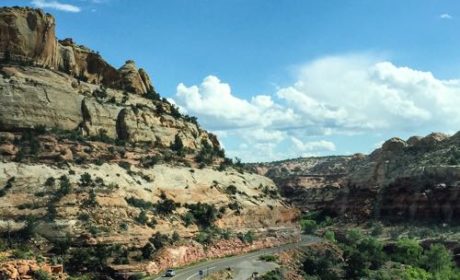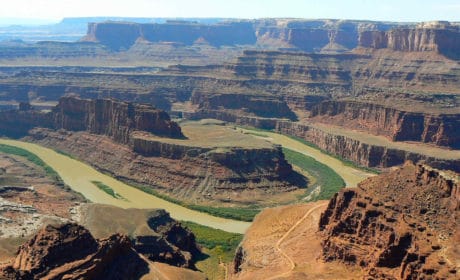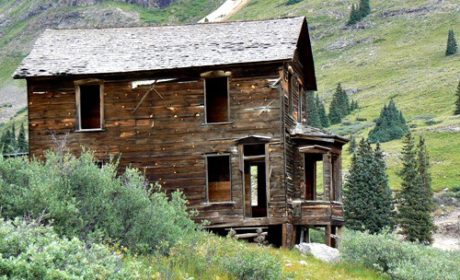Let me take you on a Valley of the Gods tour, one of my favorite off-the-beaten-path Utah destinations. Alan’s, too. It’s the very best kind of do-it-yourself adventure.
If you’ve hung around My Itchy Travel Feet for very long, you know that Alan and I enjoy nothing better than to take the road less traveled. That’s exactly what we found at Valley of the Gods off Highway 163 between Mexican Hat and Bluff in southeastern Utah.

Table of Contents
Directions to Valley of the Gods, Utah

After driving the Monument Valley scenic drive, head north on Highway 163 for the 32-mile drive to the east entrance of Valley of the Gods. At the nondescript turnoff, you’ll discover a miniature version of what you’ve just experienced in Monument Valley with two big exceptions. You won’t find as many people or souvenir stands, here. Yay!
The valley can also be accessed from Highway 261 (west entrance). This is especially convenient if you’re driving down from Cedar Mesa on the Moki Dugway or you’ve just visited Goosenecks State Park (official website).
Located near Mexican Hat, and also Bears Ears National Monument, Valley of the Gods offers stunning red rock formations—although not as many as in Monument Valley—in a quieter setting. Drive the rough dirt road through the valley to discover it for yourself.
Boomer photographers, don’t forget to plan a photo shoot. You’ll find plenty of quintessential American Southwest scenery to document.
There are no fees or permits required to explore, drive, hike or camp in Valley of the Gods. In my opinion, it’s one of the best parks in Utah.
Boomer Travel Tip
We bring a Utah Road & Recreation Atlas on all of our Utah adventures.
Let’s travel on a Valley of the Gods tour

A Valley of the Gods tour is mostly a Valley of the Gods scenic drive. The 17-mile dirt road (FR 242) winds through red sandstone buttes and pinnacles that are 250 million years old.
Through the eons, the elements—ice, wind, water—have carved the distinctive look of Rooster Butte, Lady in the Bathtub, Seven Sailors Butte, and many other monoliths that have been given quirky names by the locals.
There was a time when I could advise that, depending on the time of year, you would see a few cars, but for the most part have the valley mostly to yourself. Sadly, that is no longer true, unless you get lucky—which still could happen.
In recent years, the area has become more well known, so expect to share the stunning scenery during the busy season. But the valley is still not as heavily visited as Monument Valley. And you’ll experience a wildness that’s hard to find these days.
Since this is Bureau of Land Management (BLM) land, the area is totally undeveloped. Camping is permitted although there are no facilities whatsoever. And no campfires allowed!

Valley of the Gods is the kind of place where you want to park the car and go exploring. Or drag out the beach chairs, books, something cold to drink and just be.
Another option is to arrive for a sunset to watch the sunlight’s reflection on the ancient Cedar Mesa sandstone.
Although it’s fine to explore by foot (there are no marked trails), watch out for rattlesnakes in the underbrush when hiking in Valley of the Gods during warm weather. This is high desert country so bring plenty of water, wear a hat and use sunscreen.
It’s important to remember that this land is sacred to the Navajo so be respectful. To them, the sandstone buttes and spires represent ancient Navajo warriors.
The Bluff Utah visitors website offers an excellent mile-by-mile description and map of what you’ll see at Valley of the Gods. A visit also makes a good side trip when driving Trail of the Ancients Scenic Byway in Utah.
Best time to visit Valley of the Gods

Although Valley of the Gods is open year-round, Alan and I prefer visiting in the fall (September-October) when golden-colored wildflowers contrast against the red rock scenery. Spring (March to early June) is a good time to explore the valley, too.
If you’re not a fan of heat, avoid visiting during the summer months. Also, in summer, monsoons can turn the road into a muddy, impassable mess so check the weather before starting your drive.
Boomer Travel Tip
Planning a trip to Utah. Start your research with at our Utah Travel Resources page.
See Valley of the Gods in the fall

Alan an I first explored Valley of the Gods on the way to a photography workshop in Canyonlands and Arches National Parks. We were amazed at how much the valley reminded us of her famous sister, Monument Valley, just 30 miles to the south.

On this fall road trip, yellow and gold wildflowers decorated the valley floor. We took our time driving Valley of the Gods’ curvy, dirt road, stopping at many of the pull offs to get out and explore.
To say that we were smitten is an understatement, especially after spending the night at Valley of the Gods Bed and Breakfast near Highway 261 at the valley’s west entrance.
Explore Valley of the Gods in the winter

One January, Alan and I attended the Bluff Balloon Festival, and enjoyed a side trip to explore a snowy Valley of the Gods. The area had received just enough snow to make for a fun photography session.

We drove a little ways in, then parked the car to walk in the snow. Being a southern girl, I had never seen snow sparking like tiny diamonds in the bright sunlight and took photo after photo.
Boomer Travel Tip
Need to update your road trip gear? Start with our recommendations for best road trip gear.
Where to stay

Where do you stay on an off-the-beaten-path Utah adventure like this one? As I mentioned above, Valley of the Gods Bed and Breakfast is located near the valley’s western entrance.
It’s an experience that’s all about living green in off-the-grid accommodations. You don’t want to miss it.
A more luxurious option, Desert Rose Inn & Cabins in Bluff, Utah makes a convenient headquarters for exploring this entire region of southeastern Utah. Alan and I have enjoyed both lodging choices and recommend either one of them.
Bluff Dwellings Resort is another luxury property in Bluff that we’d like to experience.
More things to do in southeastern Utah

After exploring Valley of the Gods and Monument Valley, what else is there to do in southern Utah? You name it— admire the San Juan River’s curvy path at Goosenecks State Park, drive the Moki Dugway, photograph the view at Muley Point, or explore remote Natural Bridges National Monument.
Are you looking for prehistoric ruins? You’ll find plenty on Cedar Mesa, after driving up Moki Dugway.
Or cut across the Colorado Plateau on Butler Wash Road to explore more prehistoric ruins and petroglyphs on Comb Ridge. Both are part of the recently designated Bears Ears National Monument.
The San Juan River winds through the Bluff area on its way to Lake Powell. Rafting trips offer another opportunity to explore rock art drawings and cliff dwellings. Floating the San Juan River is definitely on our to do list on a future visit to Bluff.
No matter how often Alan and I visit this part of Utah, a quick drive into Valley of the Gods is always on our Utah road trip itinerary.
Save to Pinterest




